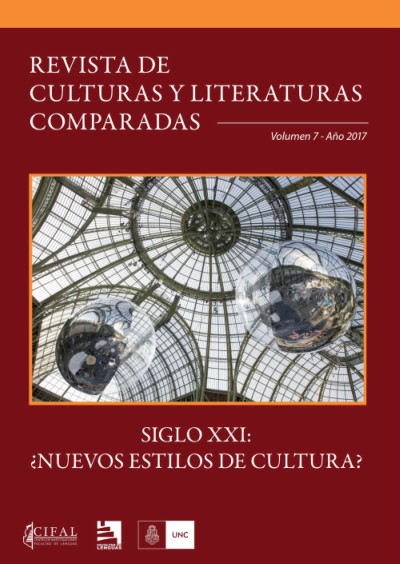Culture at the Crossroads of Millennia
Keywords:
posmodernisms, post-posmodernism, pseudo-modernismo, digimodernism, metamodernismAbstract
In the following article, we will try to show what are the characteristics or definitions of postmodernism that have operated in such a way as to prevent us from describing some concept within the frame of the so-called post-posmodernisms, following the same strategies as those manipulated by contemporary critics. Then, we will briefly analyze some notions that are used to refer to the plethora of forms of culture that has been generated (or those that are already in the process of waning) under the umbrella term post-postmodernisms, such as pseudo-modernism, digimodernism, metamodernism.
Downloads
References
Barthes, Roland. “The Death of the Author’’. Image. Music. Text. Trans. Stephen Heat. New York: Noonday, 1977.
Baudrillard, Jean. “The Precession Of Simulacra”.Media and Cultural Studies: Keyworks. Ed. por Durham and Kellner. London: Blackwell, 2001.
Berlin, Isaiah. The Roots of Romanticism. Princeton: Princeton University Press, 2001.
Best, Steven & Douglas Kellner. Postmodern Theory: Critical Interrogations. New York: Guilford, 1991.
Bourriaud, Nicholas (Ed.). Altermodern, Tate Triennal 2009. London: Tate Publishing, 2009.
Brooker, Peter (Ed.). Modernism/Postmodernism. London: Routledge, 1992.
Calinescu, Matei. The Five Faces of Modernity. Bloomington: Indiana University Press,1987.
Carter, Angela. Nights at the Circus. London: Chatto & Windus, 1984.
Debord, G. La sociedad del espectáculo. Trad. por José Luis Pardo. Madrid: Revista Observaciones Filosóficas, 1967.
---. Comentarios sobre la sociedad del espectáculo. 1988. Trad. Carme López y J. R. Capella. Barcelona: Anagrama, 1990.
Deleuze, Gilles & Felix Guattari. A Thousand Plateaus. 1980 Trad. Brian Masumi. Minneapolis: University of Minnesota, 1987.
Dick, Philip. Do Androids Dream of Electric Sheep? New York: Ballantine Books, 1968.
Eco, Umberto. Los límites de la interpretación. 1990. Barcelona: Editorial Lumen, 1992.
Eagleton, Terry. The Illusions of Postmodernism. Oxford: Blackwell Publishing, 1996.
Foucault, Michel. The Order of Things. 1966. New York: Vintage, 1994.
---. La arqueología del saber. México: Siglo XXI, 1969.
Fowles, John. The French Lieutenant’s Woman. NewYork: New American Family, 1969.
González de Gatti, Marcela y Alejandra Portela. Postmodernisms and their Manifestations in Anglophone Novels. Facultad de Lenguas, Universidad Nacional de Córdoba, 1997. Informe de investigación no publicado.
Graves, Robert. The Real David Copperfield. London: Bradbury and Evans,1933
Harvey, David. The Condition of Postmodernity. Cambridge: Blackwell, 1990.
Hassan, Ihab. The Postmodern Turn. Ohio: Ohio University Press, 1987.
Heiser, Jorg. (Ed.) Romantic Conceptualism. Bielefeld: Kerber, 2008.
Hutcheon, Linda. A Poetics of Postmodernism. Cambridge: University Printing House, 1988.
---. The Politics of Postmodernity. London: Routledge, 2002.
Kirby, Alan. “The Death of Postmodernism and Beyond’’. Philosophy Now. A Magazine of Ideas, 2006.
---. Digimodernism: How New Technologies Dismantle the Postmodern and Reconfigure Our Culture. London: Continuum, 2009.
Lipovetsky, Gilles. Hypermodern Times. Cambridge: Polity Press, 2005.
Lovejoy, Arthur. The Thirteen Pragmatisms and Other Essays. Baltimore: John Hopkins U. Press, 1963.
McHale, Brian. Postmodernist Fiction. London: Routledge, 1987.
Nabokov, Vladimir. Pale Fire. New York: Vintage, 1962.
Ollman, Bertell. “Critical Realism’’. After Postmodernism. José López y Garry Potter, Eds. London: The Athlone Press, 2001.
Rhys, Jean. Wide Sargasso Sea. London: Norton Company, 1966.
Sadleir. Michael. Fanny by Gaslight. London: Appleton, 1940.
Samuels, Robert. “Auto-modernity after Postmodernism: Autonomy and Automation in Culture, Technology, and Education”. Digital Youth, Innovation and the Unexpected. T. Mcpherson, Ed. Cambridge: The MIT Press, 2008.
Vermeulen, Timotheus y Robin van den Akker. “Notes on Metamodernism’’. Journal of Aesthetics and Culture 2.1 (2010).
Voegelin, Eric. “Equivalences of Experience and Symbolization in History”. Ed. E. Sandoz, vol. 12 of The Collected Works of Eric Voegelin. Baton Rouge: Louisiana State University Press, 1989.
Vonnegut, Kurt. Slaughterhouse-five. New York: Dell, 1966.
Woolf, Virginia. Freshwater. Loon: Houghton Mifflin Harcourt, 1935.
Published
How to Cite
Issue
Section
License
Aquellos/as autores/as que tengan publicaciones con esta revista, aceptan los términos siguientes:
a) Los/as autores/as conservarán sus derechos de autor y garantizarán a la revista el derecho de primera publicación de su obra, el cual estará simultáneamente sujeto a la Licencia de reconocimiento de Creative Commons.
b) La cesión de derechos no exclusivos implica que la publicación de los artículos en la presente revista no quita la posibilidad o el derecho al autor/a de publicar su obra de manera posterior en otras revistas u órganos editoriales y la autorización por parte de los/as autores/as para que el trabajo sea depositado en los repositorios institucionales, tales como el Portal de Revistas de la Universidad Nacional de Córdoba.



